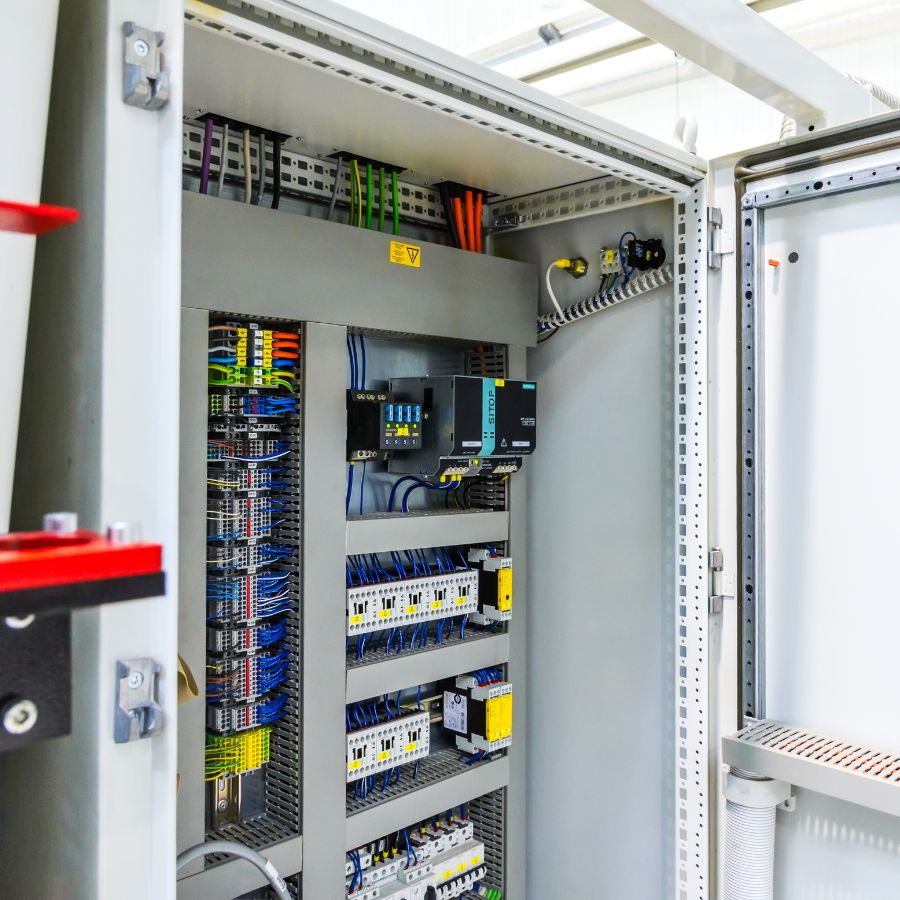

We are your reliable, trusted and professional company when it comes to Electricity & Power Systems in Uganda
At Fern Engineering & Supplies, we design, install, and maintain dependable electricity and power systems for homes, offices, factories, schools, and farms across Uganda.
We know your operations need steady power and because of that, we build systems that keep lights on, machines running, and data safe. Whether you rely on Umeme, run generators, or plan a solar hybrid, we help you choose equipment that fits your load, your budget, and your growth plans.
A power system is a set of parts that work together to give you constant energy to run your operations and activities. The main supply feeds your distribution board. We have Stabilizers and UPS units that smooth out dips and spikes. Batteries and inverters to deliver silent backup.
Generators add long endurance during extended outages and solar panels to reduce bills and support daytime loads. With the right design, each part plays its role so you avoid surprises when UMEME goes off.
Uganda needs solutions that handle heat, dust, voltage swings, and frequent switching between sources. We size cables correctly, set up earthing, and install surge protection that saves your electronics during storms.
We also configure automatic changeover so your generator or inverter takes over without drama. We also plan for service, since even the best equipment needs routine checks. You get a system that works today and stays reliable for years, paka last.
With our highly qualified, motivated and experienced team ensures that, customers’ requirements and specifications are adhered to blend with a professionalized work execution.

We build safe distribution boards with labeled circuits, quality breakers, RCDs, and surge devices. We install proper earthing and bonding that meets standards, then test and document results. We upgrade old wiring where insulation has aged, replace weak isolators, and organize clean cable routes. For factories and apartments, we design main switchboards, busbars, and metering that support expansion. Your site runs safely and passes inspections with ease.

We install online and line-interactive UPS units for servers, clinics, and POS systems. These protect sensitive devices from brownouts and brief outages. For homes and small offices, we provide inverter and battery systems that carry lights, TVs, routers, and fridges for hours. Voltage stabilizers protect equipment from low or high voltage, which is common when the neighborhood loads shift. We recommend models that match your load and your area voltage behavior.

At Fern Engineering & supplies, we handle professional and trusted energy auditing purposed to identify areas of energy wastage and find out where energy utilization can be improved as well as energy-saving opportunities in the various sections of the factory. Upon audit, we craft curbing solutions at affordable rates.

We supply diesel and petrol generators from small 5 kVA units for homes to industrial sets above 500 kVA for estates and factories. No matter your needs, our technicians service engines, change filters and oils, check coolant, and test under real load. We stock most spares and respond quickly, so your generator does not fail when you need it most.
We begin with a load assessment. We list your appliances and machines, note their run patterns, then measure actual consumption where possible. We also look at outage frequency, voltage quality, and the hours you operate. This helps us decide the right mix of grid, solar, inverter, UPS, and generator.
During the site visit, we check wiring condition, space for equipment, and ventilation. We ask about future plans, such as extra cold rooms or new production lines. We then propose two or three options with clear pros, cons, and costs. You choose a path that matches your budget and risk tolerance.
A hybrid solar system uses panels, an inverter, and batteries to power loads during the day, store extra energy, and ride through outages. When the sun is strong, panels run your appliances and charge batteries. At night or during a blackout, the system switches to batteries, then to grid or generator if needed.
You can prioritize what matters most, such as lights, routers, and fridges. Many systems include monitoring on your phone, so you see solar production, consumption, and battery status. Hybrid setups reduce bills and keep your essentials on, which is useful in Kampala and upcountry where outages can be long.
Generator size depends on your total running load and the starting current of motors and compressors. We calculate base load, add a margin for starting, and factor in the power factor of your devices. For homes, 5 to 10 kVA often covers essentials. For workshops and apartments, we size higher to handle pumps and welders.
We also consider noise, fuel use, and service access. A slightly larger generator can run cooler and last longer. An undersized one strains and fails early. We present fuel consumption figures and typical service intervals so you understand the lifetime cost, not only the purchase price. You make a choice that saves money over time.
Backup time depends on battery capacity and the total load connected. A small online UPS might hold servers for 15 to 30 minutes, enough for safe shutdown or generator start. A home inverter with good batteries can support lights, TV, and internet for several hours, especially if you avoid heavy appliances.
We design backup around your priority circuits. We separate essentials such as lighting and routers from heavy loads like microwaves and kettles. During commissioning, we show you expected runtimes at typical usage. If you need longer backup later, you add battery capacity or reduce non-essential loads to stretch runtime.
Yes, solar performs well across Uganda. Roof space and shading matter more than location. In the city, hybrid systems offset daytime consumption and stabilize sensitive loads. Upcountry, solar plus batteries and a generator can handle even unreliable grid connections. You save fuel and avoid frequent trips to buy diesel.
We check roof structure, orientation, and shading from nearby buildings or trees. We use mounts that handle Kampala winds and seals that prevent leaks. We also plan for cleaning and access. Dust reduces performance, so a simple cleaning schedule keeps output strong. You get steady returns without complicated routines.
We install surge protection at the main board and on sensitive sub-circuits that feed servers, point-of-sale, fridges, and medical equipment. Proper earthing allows surge devices to work effectively. For tall buildings and exposed sites, we add a lightning protection system that directs strikes safely to earth.
We test earth resistance after installation and during maintenance. We also educate your team on basic storm procedures, such as checking alarms and verifying critical loads after a major strike. With these layers in place, your electronics survive storms that might have wiped them out before.
Generators need regular servicing. We change oil and filters, check belts, test batteries, and run load tests. Solar inverters need firmware updates and periodic checks on connections. Batteries require inspections for terminals and temperature. Distribution boards benefit from thermal scans to spot loose joints before they heat and fail.
We create a maintenance plan that matches your risk level. Small homes might need quarterly checks. Busy factories need monthly visits. We document each visit and track issues until closure. When a problem appears, our technicians respond quickly with tools and spares. You avoid long waits and back-and-forth stories.
Yes, we design for growth. We install distribution boards with spare capacity, choose inverters that allow more panels, and select generators that can handle near-future loads. We also lay conduits for future circuits and leave space for extra batteries. This approach reduces future costs and limits downtime during upgrades.
When you plan a new wing, cold room, or extra servers, call us early. We update the load assessment and confirm that your backbone can handle the change. If you need an upgrade, we schedule it during low activity hours, such as overnight or a weekend, so your work continues smoothly.
We start with a site survey and load assessment. We share a clear quote with options, timelines, and payment plans. Once you approve, we schedule work, order equipment, and mobilize technicians. We protect floors and furniture, keep the site neat, and coordinate any shutdowns with your team.
Most home inverter installations finish in one day. Small solar hybrids take two to three days. Larger generators and switchboards take longer, especially if civil works are needed for plinths and ventilation. We test systems thoroughly, train users, and hand over documents. You get contacts for support and maintenance, then we follow up after a week.
Safety is fundamental when it comes to Fern Engineering. We use quality breakers, RCDs, isolators, and correct cable sizes. We label circuits clearly and install lockable panels to keep children and untrained staff away. For generators, we plan ventilation and exhaust routing that keeps fumes outside and away from windows.
We also train your team. You learn safe start and stop procedures, how to read indicators, and what to check before calling for help. We provide simple guides and stick labels on key points. With these habits, your system runs safely and your people stay confident.
Schedule a free consultation with our team and let’s make things happen!